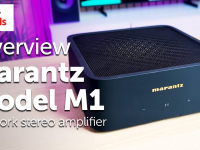
As with other systems of its ilk, the HEOS has just received a V2 makeover, the components have been given a spruce up to take into account any new technology that they may benefit from in what is a very busy field. Whilst we’d love to review every product in the range, brevity requires us to narrow things down, so today we’ll be looking specifically at the LINK HS2 to see if the updates and tweaks have been worthwhile.
Japanese audio giant Denon’s HEOS range proved to be a worthy contender to the multi-room crown that sits firmly atop of Sonos’ brow. Whilst the equipment may have been similar in principle, Denon added a few extra features that marked them out as unique, with products such as the LINK offering a greater range of connectivity and usability than its Sonos equivalent.
The original LINK was probably the niftiest of Denon’s boxes first time around. Effectively a minimalist network streamer, the LINK was designed to stream music across a home network or from online services, with all control coming from a mobile phone, tablet or laptop. Digital inputs on the back allowed other digital devices to piggyback off the Denon’s high-quality in-build digital-to-analogue converter, making the LINK an easy way to upgrade a tired digital front end in one fell swoop. A set of phono inputs also made it possible to connect an analogue device, making it easy to play that source over the HEOS network for those with multiple HEOS devices in the home. It was a very handy bit of kit. The new one is equally handy, particularly with the upgrades.
One of the limitations that the HEOS network originally had was that files could only be played back in up to CD quality. Anyone who wanted to playback high-res audio was out of luck, an issue that saw it on level pegging with the equally hamstrung Sonos. Not so this time. As high-res audio continues to become a wider spread attraction, serious hi-fi components must show their high-res credentials – something Denon have managed this time around. Capable of playing WAV, ALAC and FLAC in formats up to 24-bit/192kHz sample rates, the LINK HS2 leapfrogs ahead of similar products. There’s even support for AIFF and DSD incoming via a future software update.

Denon have also added direct Bluetooth support, great if you’ve got guests around for the evening and don’t want to go to any extra effort with downloading the app to extra devices.
Speaking of the app, Denon’s is definitely one of the nicest we’ve used, both functionally and stylistically. Its clean and intuitive interface makes selecting tracks, either from your own library or from the host of supported streaming services such as Tidal, Spotify and Napster a breeze. It also allows the user to select which zones they want to play, making it easy to separate or link areas that have HEOS devices in. Available for both iOS and Android devices, the app is a huge feather in the Denon’s already impressive cap.
As the LINK HS2 is primarily a hi-fi component when used in isolation, we picked out good quality gear to match. Initial testing was performed with the Cambridge CXA80 amplifier and Monitor Audio Silver 2 bookshelf speakers, but the LINK has potential to fit in any system at any price and work admirably. Music playback was from the shop’s NAS drive, full of files of various bitrates and filetypes, as well as Spotify and Tidal. The LINK’s phono outputs were used in order to take advantage of the onboard DAC.
First up was our most listened to album in recent months, Radiohead’s fantastic A Moon Shaped Pool. Constant playback of this latest masterpiece gives us a real familiarity with the songs, and ultimately how they perform on various systems. Knowing your demo material will always help you to spot how well a component is doing its job. Glass Eyes is one of the album’s most haunting tracks, with the rippling, almost liquid effect of the piano giving an ethereal atmosphere from the get go. Instrument separation was very good, helping to isolate the individual layers of the track. The strings that punctuate the song were expressive without being shrill, whilst Thom Yorke’s distinct vocal stylings were clear and easy to understand. The fact that we could play this album in the original 24-bit WAV format that the band offered it in upon release no doubt helped this extra layer of clarity and detail retrieval come to the forefront, proving Denon’s decision to include support for the format to be a salient one.

Lower quality files held up well, too. Definitely something of a rarity, the 2002 release by electronic act Faultline, Your Love Means Everything, somehow managed to feature some absolutely top-draw guest artists considering that the album was and is the only one ever to release under the name. The Flaming Lips, Chris Martin of Coldplay and Michael Stipe of REM all perform, and the tracks that they feature on are no mere throwaway guest spots for a quick buck. The Chris Martin-featuring Where Is My Boy? in particular is a real standout. Whilst our current store version is the CD release, our NAS drive does contain an earlier version in much lower quality MP3, which unfortunately belies the overall quality of the production. The Denon found it easy enough to cope with these shortcomings, however. Where Is My Boy? sees Martin’s vocal sat atop a gritty beat, a deep bass drum and static making up the basis of the song. It’s pretty much the direction the world wanted Coldplay to go in before they, well, didn’t! Martin’s vocal sounded fantastic through the LINK, but the most impressive part was the retrieval of information from such a poor quality file. The Denon made it sound like the FLAC version at times, which was a real credit to it.
Listening to many types of tracks and files proved that the Denon was capable of pulling this off numerous times, and seemed to favour no one particular type of music. Its bass performance was very good, and as mentioned previously, detail retrieval and soundstaging were pretty much fantastic for a streamer at this price. Whether you fancy multi-room or not, the LINK HS2 is a great place to start streaming your music. Recommended!
Shop with Richer Sounds today.
Author: Chris, Liverpool store





